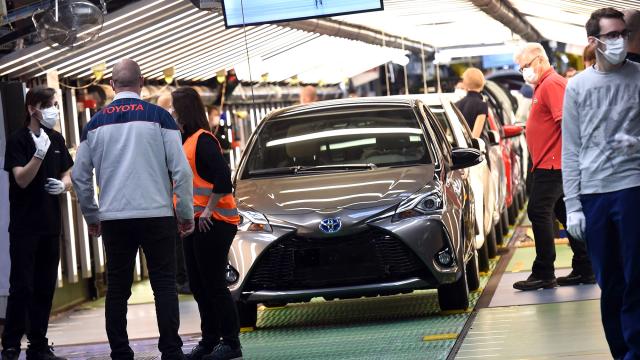As the entire automotive industry continues reeling from a global semiconductor shortage, many manufacturers have been forced to temporarily shut down production, or just go ahead and build cars without necessary components and store them until a later date. Not Toyota, though.
Toyota was prepared for the microchips to dry up. Not because it had a premonition that the pandemic was coming, but because it — along with the entire Japanese car industry — went through a similar ordeal after the devastating Tōhoku earthquake of 10 years ago. Except, unlike its peers, Toyota learned from that episode, and instituted policies that are allowing it to maintain a steady pace of production today. An article published Wednesday by Bloomberg Businessweek explained the automaker’s inventory workflow:
Toyota asks its Tier 1 suppliers to input detailed information about their most obscure parts and materials providers in a complex database that it maintains. Using this system to glean information about, say, a single headlight Toyota purchases for one of its cars, it can get information as granular as the names and locations of the companies that make the materials that go into surface treatments used on those headlights’ lenses and even the producers of the lubricants used on the rubber pieces in the assembly, Toyota spokeswoman Shiori Hashimoto says.
These lines of communication alerted the company early on that it needed to stockpile chips. “The process of making semiconductors is complex, and the facilities used to create them are specialised,” Hashimoto says. “With that in mind we’ve needed to make sure there’s enough stock to cover a period of potential supply disruption.”
While most automakers keep lines of communications open with their Tier 1 and 2 suppliers, they generally don’t know what’s going on with their suppliers’ suppliers. This is where the first sign of a potential inventory crisis emerges, and what Toyota was attuned to pick up on before anyone else by keeping an eye on every step along the chain of production of a given part.
In the aftermath of the 2011 earthquake, Toyota’s primary plant went dark for three months. Parts were missing, and Toyota set on a mission to determine the most “at-risk items” for stockpiling, Bloomberg Businessweek reports. The result was a list of 1,500 components.
While Toyota’s seemingly been preparing for this eventuality for a decade, other companies in the field are scrambling to adapt as quickly as possible. One of those is Dana, the American firm known for manufacturing axles and driveshafts, among other parts. Like Toyota, Dana is building out its inventory management system; it’s also sourcing components from multiple suppliers at once, and asking some to hold a backlog of certain parts, according to an Automotive News story published last week.
Like Toyota and Dana, everyone from small suppliers to established multinational automakers are exploring ways to untether themselves from the “just-in-time” approaches to production that have governed manufacturing up until recently. Nissan Chief Operating Officer Ashwani Gupta admitted to Bloomberg that it probably should’ve looked into that years ago:
“The semiconductor crisis is one that everyone in the world could have avoided,” Nissan Chief Operating Officer Ashwani Gupta says. The problem is many automotive companies didn’t rigorously manage their supply chains when it comes to Tier 3 or Tier 4 suppliers. “We often don’t know the risks down there,” he says. Nissan is now looking to improve its digital supply chain management tools. “Every expert is good at backward analysis,” Gupta says. “It’s harder to look forward. Nissan has learned from this.”
Critics argue that stockpiling will inevitably lead to more waste — though perhaps only if companies stockpile indiscriminately. It can only help Toyota to ascertain a better understanding of where the parts that comprise its parts are at any given moment, rather than simply expecting them to always be there and becoming surprised when they’re not. By that point, it’s already too late to do anything about the problem.
But it took a natural disaster to expose this flaw in Toyota’s supply chain management 10 years ago, while many of its rivals failed to correct as swiftly. The ongoing pandemic has produced a similar moment for the global automotive sector. The question this time around is: who will learn, and who won’t?
